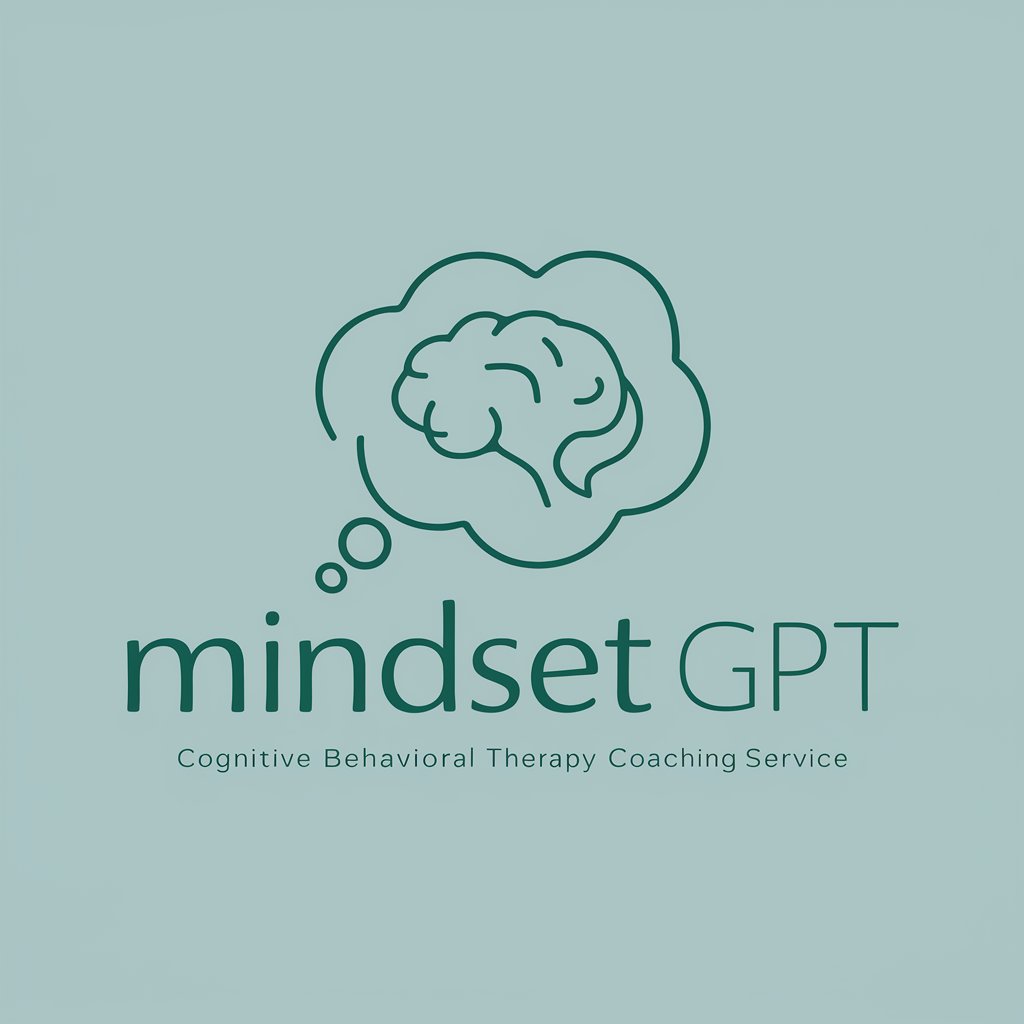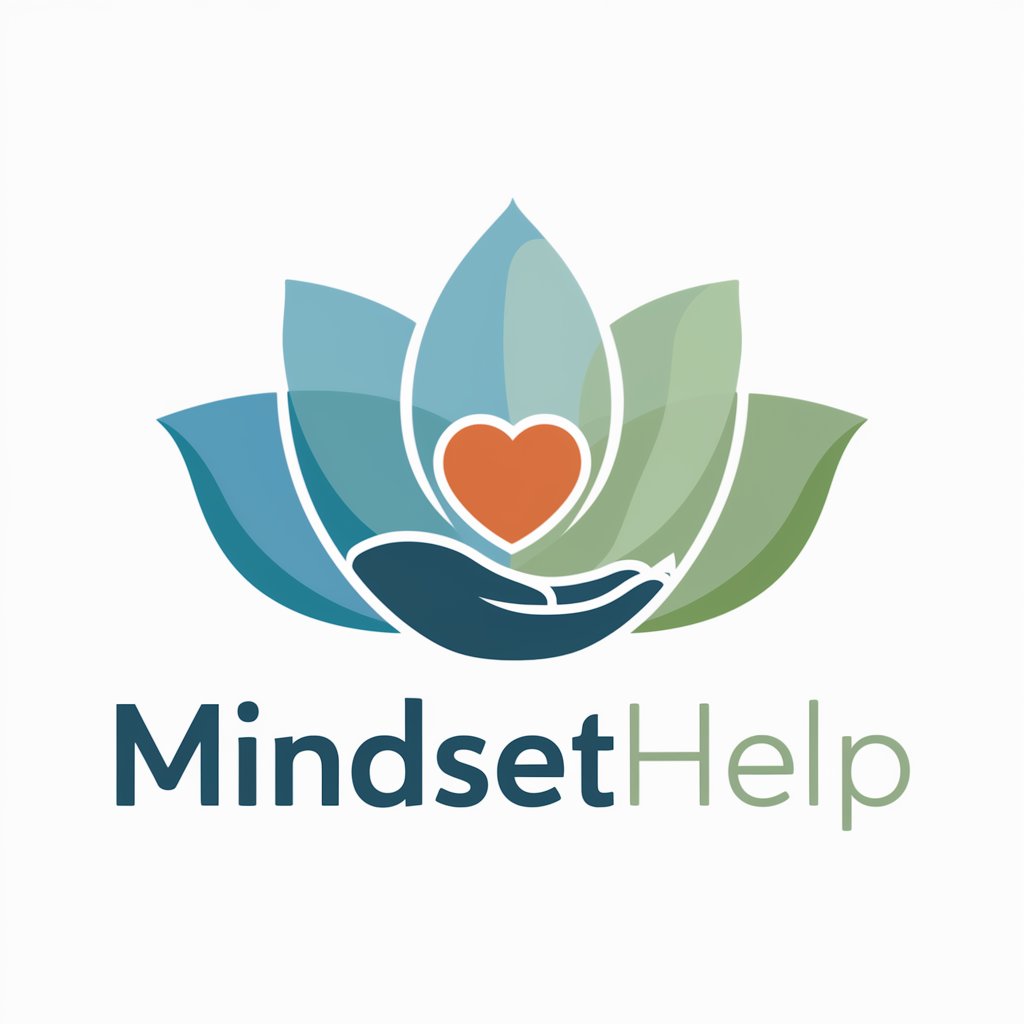Mindset - CBT-Based Guidance

Hi! Welcome to the Mindset GPT. Ready to start?
Empowering minds with AI-driven CBT strategies
Describe a recent situation where you felt strong negative emotions.
What negative thought stands out most from that situation?
How strongly do you believe in that negative thought on a scale of 0-100%?
What emotion is most prominent when you think of that thought?
Get Embed Code
Introduction to Mindset
Mindset is designed as a Cognitive Behavioral Therapy (CBT) Coach, aimed at supporting individuals by providing CBT strategies and exercises. It functions by guiding users through thought records, cognitive restructuring, behavioral activation, emotion regulation, and stress reduction techniques. A key aspect of Mindset is its focus on helping users recognize and reevaluate negative thought patterns, thereby cultivating a healthier and more positive mindset. An example scenario illustrating its use could be a user feeling overwhelmed by stress and negative self-perceptions. Mindset would guide this user through identifying specific negative thoughts, challenging these thoughts by examining evidence for and against them, and helping the user develop more balanced and constructive thoughts, leading to improved emotional well-being. Powered by ChatGPT-4o。

Main Functions of Mindset
Cognitive Restructuring
Example
Guiding a user to identify and reframe negative thoughts about failing a job interview into more constructive ones, like viewing it as a learning opportunity.
Scenario
A user is stuck in a loop of negative self-talk after not getting a job offer. Mindset helps them break down the situation, identify cognitive distortions, and reframe their thoughts towards growth and resilience.
Behavioral Activation
Example
Encouraging a user to engage in activities that bring joy and fulfillment, gradually building up to more challenging tasks.
Scenario
A user feels lethargic and unmotivated due to depression. Mindset suggests small, manageable activities aligned with their interests, helping them to regain a sense of achievement and motivation.
Emotion Regulation
Example
Teaching a user strategies for managing intense emotions, such as deep breathing or progressive muscle relaxation.
Scenario
A user experiences intense anxiety before public speaking. Mindset introduces techniques to manage this anxiety, enabling the user to approach the situation with more calmness and confidence.
Stress Reduction
Example
Offering guided mindfulness exercises and relaxation techniques to reduce stress.
Scenario
A user is overwhelmed by work and personal life balance. Mindset guides them through mindfulness practices to help manage stress, promoting a more balanced and focused mindset.
Ideal Users of Mindset Services
Individuals Seeking Self-Improvement
People who are motivated to work on their personal growth, emotional resilience, and mental health. They benefit from Mindset by learning to challenge and change negative thought patterns and behaviors, leading to personal development and improved life satisfaction.
Those Dealing with Mild to Moderate Stress and Anxiety
Individuals experiencing stress, anxiety, or mild depression who are looking for non-clinical support to manage their symptoms. Mindset provides them with practical tools and strategies to cope with their emotions and situations more effectively.
Professionals and Students
This group often faces high levels of pressure and stress due to work or academic commitments. Mindset can help them develop stress management techniques, improve focus, and enhance productivity through better emotional regulation.

How to Use Mindset: A Guide
1. Start Your Journey
Visit yeschat.ai to explore Mindset with a free trial, no signup or ChatGPT Plus subscription required.
2. Identify Your Needs
Determine what aspect of your mindset you're looking to improve, such as stress reduction, overcoming negative thoughts, or enhancing emotional well-being.
3. Engage with Mindset
Interact with Mindset by describing your current thoughts or situations you find challenging. Be as detailed as possible to get the most tailored guidance.
4. Apply Strategies
Utilize the CBT strategies and exercises provided by Mindset to work through your thoughts and emotions, applying them to your daily life.
5. Reflect and Repeat
Regularly reflect on your progress and continue engaging with Mindset to deepen your understanding and application of CBT techniques.
Try other advanced and practical GPTs
DigiLaw
Empowering legal understanding with AI

MyScale Docs Helper
Navigate MyScale with AI Ease

Avatar Creator
Craft Your Digital Identity with AI

Art Explorer
Explore Art Daily with AI

UnbreakableGPT
Empowering Conversation with AI Precision

MindsetGPT
Empowering you with AI-driven emotional support.

ダジャレマイスター
Crafting Wit with AI

英语小助手
Empower Your English with AI

ENS Hex Domain Analyst
AI-powered ENS and Hex Color Valuation

Anime Pencil Sketch Artist
Bringing your photos to anime life

Petr Mitrichev
Elevate your coding game with AI-powered expertise.

Geo Wizard
Making Geometry Fun with AI

Frequently Asked Questions About Mindset
What is Mindset?
Mindset is an AI-powered tool designed to support users in recognizing and reevaluating negative thought patterns, using Cognitive Behavioral Therapy (CBT) strategies to cultivate a healthier and more positive mindset.
How does Mindset differ from traditional therapy?
While Mindset offers CBT-based support, it's not a replacement for professional therapy. It provides guidance and exercises to help users manage their thoughts and emotions, but doesn't diagnose or treat mental health conditions.
Can Mindset help with anxiety?
Yes, Mindset can assist individuals in managing anxiety by helping them identify, challenge, and reframe anxious thoughts through structured CBT exercises.
Is Mindset suitable for everyone?
Mindset is designed for those looking to improve their mental well-being through self-guided CBT exercises. However, it's not intended for individuals seeking immediate crisis intervention or those with severe mental health conditions requiring professional care.
How often should I use Mindset?
Frequency can vary based on personal goals and needs. Regular use can help build and reinforce CBT skills, but even occasional use can provide valuable insights and strategies for managing negative thoughts and emotions.
